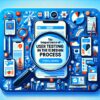Leveraging Analytics to Improve Website User Experience

—
In the digital age, understanding how visitors interact with your website is essential for crafting superior user experiences. Analytics tools serve as the compass that guides web developers and designers towards informed decisions, turning raw data into actionable insights. This article delves into the power of leveraging analytics to enhance website user experience (UX), focusing on key areas such as behavior analysis, performance metrics, and the iterative improvement process.
Understanding User Behavior
One of the primary benefits of integrating analytics into your web development strategy is the ability to deeply understand user behavior. Analytics platforms like Google Analytics provide a wealth of information about how users interact with your site, including:
– Pages Per Visit and Session Duration: These metrics can highlight whether your content is engaging enough to keep visitors browsing.
– Bounce Rate: A high bounce rate may indicate that your landing pages are not relevant or compelling to your audience.
– Exit Pages: Identifying the last pages viewed before a user exits can help pinpoint areas where your site may be losing engagement.
By scrutinizing these metrics, developers can identify which parts of their website are performing well and which areas need improvement.
Enhancing Site Performance
Website performance is a critical factor in user experience. Slow loading times not only frustrate users but also negatively impact your site’s search engine rankings. Through analytics, developers can monitor:
– Page Load Times: Analyzing how long your pages take to load allows you to identify bottlenecks and optimize accordingly.
– Mobile Responsiveness: With the increase in mobile browsing, ensuring your site is mobile-friendly is crucial. Analytics can show how your site performs across different devices.
Focusing on these performance metrics enables developers to create a smoother, more efficient user experience, encouraging longer sessions and reducing bounce rates.
Iterative Improvement Process
The true value of analytics lies in its ability to facilitate an ongoing cycle of testing, learning, and optimizing. For web developers, this means:
– A/B Testing: Compare different versions of a webpage to see which performs better in terms of user engagement and conversion.
– User Flow Analysis: Understand the paths users take through your site. This can help identify where users drop off and how the navigation can be improved.
– Conversion Rate Optimization (CRO): Use analytics to fine-tune elements of your web pages, enhancing the likelihood of converting visitors into customers.
Incorporating analytics into the iterative design process enables web developers to make data-driven improvements, thereby continuously elevating the user experience.
Conclusion
In the quest to design websites that not only look good but also perform brilliantly, analytics is an indispensable tool. It allows developers and designers to move beyond guesswork, providing a clear picture of how real users interact with their sites. By focusing on behavior analysis, site performance metrics, and the iterative improvement process, professionals can leverage analytics to significantly improve website user experience.
In a world where user expectations are constantly evolving, staying informed and adaptable is key. Analytics empowers web developers to not just react to the latest trends, but to anticipate user needs, crafting web experiences that are not only intuitive and engaging but also deeply rewarding.
—
Focusing on clear, actionable insights and structured around key aspects of UX design, this article is crafted to assist web developers in harnessing the full potential of analytics to enhance the user experience on their websites. With concise H2 and H3 headings, it is optimized for both readability and search engine visibility, ensuring that it reaches its intended audience effectively.


